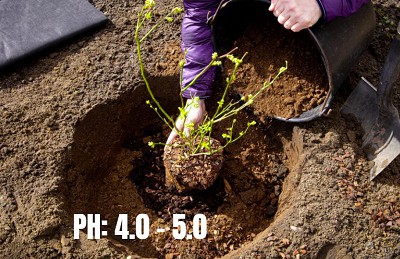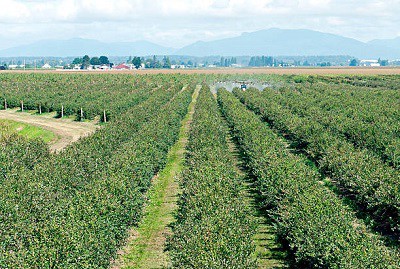Blueberry season in North Carolina begins in May, June, or July, and it’s during these months that families can visit u-pick farms and enjoy these sweet, vibrant fruits as they ripen on the bushes.
If you’re contemplating when to plant blueberries in North Carolina, February and March or November to December are the best time of year for gardening throughout the state.
Read below for more details on the planting schedule.
Table of Contents
Best Time to Plant Blueberries in North Carolina
You can grow blueberries in yard at any time, so long as the ground is frost-free and easy to plow.
However, there are still certain months when planting blueberry bushes would produce superior results, and it’s best to stick to them when gardening in NC.
- To begin with, you should start by planting bare-root blueberries in February and March while they’re still dormant, with January being another possible alternative as well.
- Stick to late winter gardening unless you live in the Coastal Plain. This region offers some flexibility regarding non-potted plants, allowing gardeners to grow them in the fall from November to December.
However, note that the ground must be sandy or well-drained and full of organic matter to ensure success, particularly if you’re growing highbush blueberries and not other varieties.
- Other than late winter, another option is to buy blueberries in containers and grow them in the fall from November to December.
In any case, purchase one to three-year-old plants. Three-year-old blueberries will bear fruits the quickest, while two-year-old and one-year-old bushes will require one or two years of growth respectively before production.
The only caveat is that older plants are more expensive, and it’s up to you to select the best option for your budget.
Lastly, another thing you may have thought about is North Carolina’s growing zones. NC spans hardiness regions 5b to 8b, but zone 5 (where people often plant blueberries in spring) accounts for such small areas of the state that you rarely ever see any planting in spring.
Tips for Planting Blueberries Successfully in North Carolina
1. Pick blueberry varieties that suit North Carolina’s climate
Rabbiteye is the most prominent option when it comes to North Carolina blueberries, as varieties under this category can grow throughout pretty much the entire state.
Other plant families like highbush and southern highbush, though useful, offer less versatility in location.
Here is a list of blueberry cultivars and their suitable planting areas:
- Rabbiteye (Climax, Premier, Powderblue, Ira)
All locations in NC below 2,500 ft. in elevation, where minimum winter temperatures measure 10℉ and higher
- Highbush (Bluecrop, Berkeley, Patriot, Elliot)
- Blueberries for western North Carolina (where elevation is above 2,500 ft)
- Can handle colder temperatures than Rabbiteye cultivars
- Adaptable to eastern and southeastern NC with extensive soil acidification and application of organic matter (often grown this way in trials only)
- Southern highbush (Blue Ridge, O’Neal, Legacy)
Cultivable in eastern and southeastern NC, similar to highbush varieties
2. Pay attention to the planting site’s attributes
Blueberries require an acidic environment to grow well. It is recommended that you lower the soil’s pH to between 4.0 and 5.0 using one or two pounds of wet sulfur every 100 square feet (less if the gardening medium is sandy and more if planting is done in clay soil).
Do this step at least three months before planting and pick a location with full sun and adequate drainage, such as a raised bed or any site that doesn’t remain wet 24 hours after heavy rain (you can dig a 6-inch deep hole and observe its moisture level to check).
3. Follow the right steps when growing blueberries
Incorporate three to four inches of peat moss or decayed pine bark into the soil down to a depth of six to eight inches. This step is essential if the planting location has little to no organic matter.
Next, plant highbush blueberries in rows eight feet apart, or ten feet apart if you’re growing Rabbiteye cultivars. The distance between plants should be four feet for highbush varieties and six feet for their Rabbiteye counterparts.
Imitate the planting depth of the container if you ordered potted blueberries, then lay three inches of pine straw or bark mulch onto the soil.
For bare-root shrubs, dig holes twice as deep and twice as wide as the plants’ dimensions.
Is It Easy to Grow Blueberries?
If your soil meets the conditions in our planting guide above, it should be pretty straightforward to grow blueberries. Just remember to remove all flowers during the first year as well, so the plant can bear fruits more sustainably.
Conclusion
Do you have any more questions concerning when to plant blueberries in North Carolina? We hope this article provided all the answers you need.
Blueberries not only taste delicious, but they also enhance the beauty of landscapes with their pink and white flowers. Now that fall is approaching, you don’t have to wait much longer to start planting beautiful blueberry bushes. Happy gardening!
Learn about the best time to grow the most common plant in North Carolina:

Hi, I am William – Floridayards’ digital content creator. My job is to find answers to all your concerns with thorough research and our team’s expert advice. I will also bring you honest reviews on the best products and equipment for raising your beautiful garden. Please look forward to our work!















